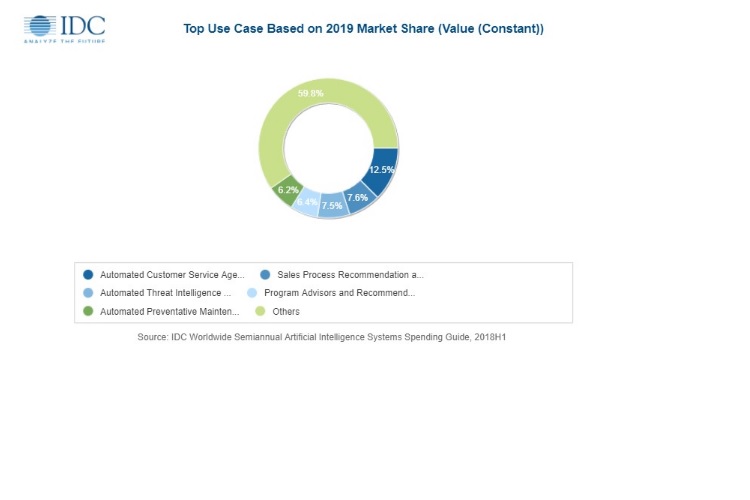
Global spending on AI systems will be led by the retail industry where companies will invest USD 5.9 billion this year on solutions such as automated customer service agents and expert shopping advisors & product recommendations. Banking will be the second largest industry with USD 5.6 billion going toward AI-enabled solutions including automated threat intelligence & prevention systems and fraud analysis & investigation systems. Discrete manufacturing, healthcare providers, and process manufacturing will complete the top 5 industries for AI systems spending this year, according to the International Data Corporation (IDC) Worldwide Semiannual Artificial Intelligence Systems Spending Guide.
The industries that will experience the fastest growth in AI systems spending over the 2018-2022 forecast are federal/central government (44.3% CAGR), personal and consumer services (43.3% CAGR), and education (42.9% CAGR).
Worldwide spending on artificial intelligence (AI) systems will reach USD 35.8 billion in 2019, an increase of 44.0% over the amount spent in 2018. With industries investing aggressively in projects that utilize AI software capabilities, the report says spending on AI systems will more than double to USD 79.2 billion in 2022 with a compound annual growth rate (CAGR) of 38.0% over the 2018-2022 forecast period.
Global spending on AI systems will be led by the retail industry where companies will invest USD 5.9 billion this year on solutions such as automated customer service agents and expert shopping advisors & product recommendations. Banking will be the second largest industry with USD 5.6 billion going toward AI-enabled solutions including automated threat intelligence & prevention systems and fraud analysis & investigation systems. Discrete manufacturing, healthcare providers, and process manufacturing will complete the top 5 industries for AI systems spending this year. The industries that will experience the fastest growth in AI systems spending over the 2018-2022 forecast are federal/central government (44.3% CAGR), personal and consumer services (43.3% CAGR), and education (42.9% CAGR).
“Significant worldwide artificial intelligence systems spend can now be seen within every industry as AI initiatives continue to optimize operations, transform the customer experience, and create new products and services”, said Marianne Daquila, research manager, Customer Insights & Analysis at IDC. “This is evidenced by use cases, such as intelligent process automation, expert shopping advisors & product recommendations, and pharmaceutical research and discovery exceeding the average five-year compound annual growth of 38%. The continued advancement of AI-related technologies will drive double-digit year-over-year spend into the next decade.”
The AI use cases that will see the most investment this year are automated customer service agents (USD 4.5 billion worldwide), sales process recommendation and automation (USD 2.7 billion), and automated threat intelligence and prevention systems (USD 2.7 billion). Five other use cases will see spending levels greater than USD 2 billion in 2019: Automated preventative maintenance, diagnosis and treatment systems, fraud analysis and investigation, intelligent process automation, and program advisors and recommendation systems.

Software will be the largest area of AI systems spending in 2019 with nearly USD 13.5 billion going toward AI applications and AI software platforms. AI applications will be the fastest growing category of AI spending with a five-year CAGR of 47.3%. Hardware spending, dominated by servers, will be USD 12.7 billion this year as companies continue to build out the infrastructure necessary to support AI systems. Companies will also invest in IT services to help with the development and implementation of their AI systems and business services such as consulting and horizontal business process outsourcing related to these systems. By the end of the forecast, AI-related services spending will nearly equal hardware spending.
“IDC is seeing that spending on both AI software platforms and AI applications are continuing to trend upwards and the types and varieties of use cases are also expanding,” said David Schubmehl, research director, Cognitive/Artificial Intelligence Systems at IDC. “While organizations see continuing challenges with staffing, data, and other issues deploying AI solutions, they are finding that they can help to significantly improve the bottom line of their enterprises by reducing costs, improving revenue, and providing better, faster access to information thereby improving decision making.”
On a geographic basis, the United States will deliver nearly two thirds of all spending on AI systems in 2019, led by the retail and banking industries. Western Europe will be the second largest region in 2018, led by banking, retail, and discrete manufacturing. The strongest spending growth over the five-year forecast will be in Japan (58.9% CAGR) and Asia/Pacific (excluding Japan and China) (51.4% CAGR). China will also experience strong spending growth throughout the forecast (49.6% CAGR).
“AI is a big topic in Europe, it’s here and it’s set to stay. Both AI adoption and spending are picking up fast. European businesses are hands-on AI and have moved from an explorative phase to the implementation stage. AI is the game changer in a highly competitive environment, especially across customer-facing industries such as retail and finance, where AI has the power to push customer experience to the next level with virtual assistants, product recommendations, or visual searches. Many European retailers such as Sephora, ASOS, and Zara or banks such as NatWest and HSBC are already experiencing the benefits of AI, including increased store visits, higher revenues, reduced costs, and more pleasant and personalized customer journeys. Industry-specific use cases related to automation of processes are becoming mainstream and the focus is set to shift towards next-generation use of AI for personalization or predictive purposes,” said Andrea Minonne, senior research analyst, IDC Customer Insight & Analysis in Europe.

 In
In
Add new comment